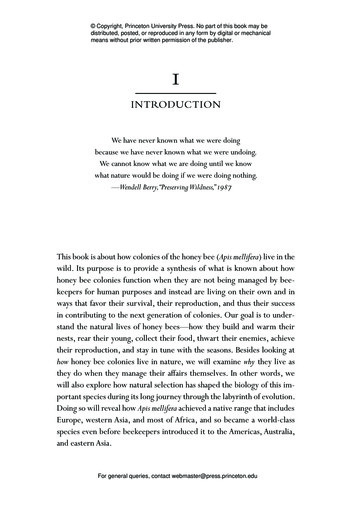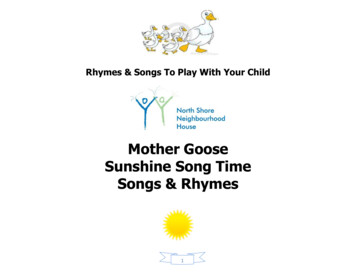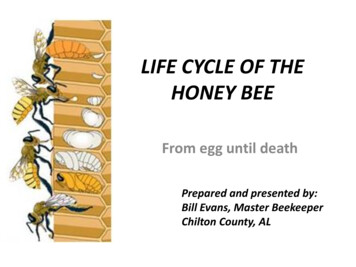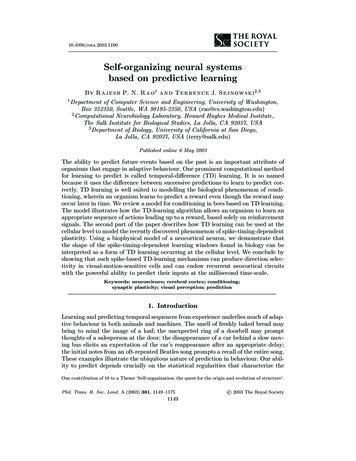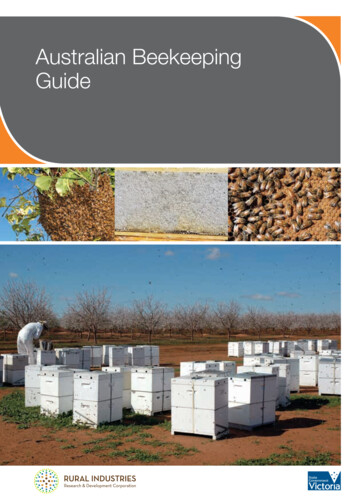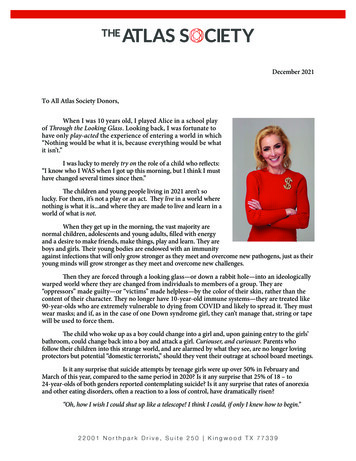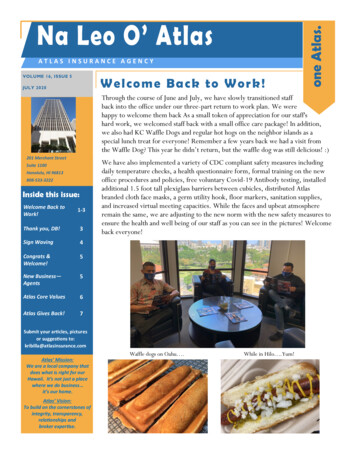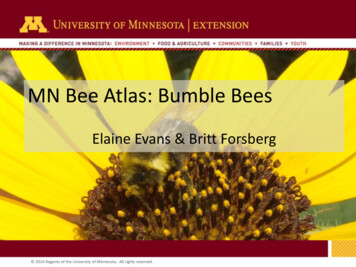
Transcription
MN Bee Atlas: Bumble BeesElaine Evans & Britt Forsberg1 2014 Regents of the University of Minnesota. All rights reserved.
Bumble bee look-alikesFlies that mimic colorationCharacteristics: Antenna variable No pollen basket One pair of wings Short, blunt mouthpartsPhoto: Eileen Miller
Clearwing MothLong curled tongueLong straight antennaeNo waistPhoto by TexasEagle
Bumble bee look-alikesLarge Carpenter Bees (Xylocopa virginica)Characteristics: Large size, robust body Yellow hair on thorax Shiny abdomen Hairy scopa on hind legs, not pollen basket Males with yellow markings, not hairs, on face Nest in hard woodPhoto: Jennifer Hopwood
Bumble bee look-alikesAndrenaCharacteristics: Small size Hairy scopa on hind legs, not pollen basketPhoto: Jennifer Hopwood
Females Often larger than males Sting presentMales No stinger “Beard” on mandible Often smaller than females Often with white or yellow facial hair Some species have enlarged eyes
Female bumble bee leg(non-parasitic)Male bumble bee legPhotos: Sam Droege
Big eyesLong antennaeRegular eyesRegular antennaePhotos: Sam Droege
Identifying bumble bees to speciesColor patterns can be important, but are not always reliableImages by Elaine Evans / Xerces Society
Identifying bumble bees to speciesThings to look at other than color patterns
Start with yellow sectionsthen follow numbersRead descriptions tosee if it fitsColor patterns can varyin the real world
Earliest emergence records in WisconsinQueensAprilMayWorkersJuneJulyMedler and Carney 1963MalesAugustSeptember
Bombus impatiens / Common Eastern bumble bee Nest underground atvarious depths Queens come out midspring Medium tongue length Select food plants:Cirsium (Thistles),Eupatorium, Solidago(Goldenrods)Photo: Gary Zamzow
Bombus impatiens / Common Eastern bumble bee Very common species Used commercially;expanding in range IUCN Status: LeastConcernHatfield et al. 2014; Xerces SocietyPhoto: Gary Zamzow
Bombus impatiens / Common Eastern bumble beeFemale Thorax mostlyyellow; wing basesyellow; usually withblack spot centrally T1 Yellow and allother abdominalsegments blackMaleIllustrations: Evans
Bombus bimaculatus (Two-spotted bumble bee) Nests underground butalso on surface, and usesnesting boxes Queens emerge early inthe spring Tongue length: medium Select food plants:Cirsium (Thistles),Hypericum (St. John’sWort), Rosa, Solidago(Goldenrods), Vicia(Vetches)Photo: Patricia Nankey
Bombus bimaculatus (Two-spotted bumble bee) Common species IUCN Status: LeastConcernHatfield et al. 2014; Xerces SocietyPhoto: Gary Zamzow
Bombus bimaculatus (Two-spotted bumble bee)Female Thorax mostlyyellow; wing basesyellow; black spotcentrally T1 Yellow; T2 withtwo yellow “W”; allother abdominalsegments black inMaleIllustrations: Evans
Bombus griseocollis (Brown-belted bumble bee) Nest on ground or abovethe surface, including inoutbuildings Queens come out midspring Tongue length: medium Select food plants:Asclepias (Milkweeds),Cirsium (Thistles),Helianthus (Sunflowers),Solidago (Goldenrods),Rhus (Sumacs)Photo: Hannah Gaines
Bombus griseocollis (Brown-belted bumble bee) Common species IUCN Status: LeastConcernHatfield et al. 2014; Xerces SocietyPhoto: Gary Zamzow
Bombus griseocollis (Brown-belted bumble bee) ThoraxFemaleMaleIllustrations: Evansmostlyyellow; wingbases yellow;black spotcentrally T1 Yellow T2 with rusty“swoosh” All otherabdominalsegments black
Bombus citrinus (Lemon cuckoo bumble bee) Parasite of B. impatiens,bimaculatus, vagans Range: All of MN Females: Thorax usually all yellow,T1-T2 usually black, T3 usuallyyellow, T4-T6 black Males: T1-T2 yellow, T3 usuallyyellow, T4-T7 black Very short malar space No pollen basket Similar species: sandersoni,vagans, rufocinctus, perplexus
Bombus citrinus (Lemon cuckoo bumble bee) Common species IUCN Status: LeastConcernHatfield et al. 2014; Xerces SocietyPhoto: Gary Zamzow
Bombus ternarius / Tri-colored bumble bee Nest underground,sometimes at large depthsin sandy soil Queens come out earlyspring Tongue length: short Select food plants:Asclepias (Milkweeds),Rubus, Solidago(Goldenrods), Vaccinium Photo: Alan Eaton
Bombus ternarius / Tri-colored bumble bee Common species IUCN Status: LeastConcernHatfield et al. 2014; Xerces SocietyPhoto: Gary Zamzow
Bombus ternarius / Tri-colored bumble bee ThoraxFemalemostlyyellow; withblack “thumbtack” or band T1 Yellow T2-T3 Rusty T4 Yellow T5 blackMaleIllustrations: Evans
Bombus huntii / Hunt’s bumble bee Rarein MN, onlyencountered in farwestern part ofthe stateMaleIllustration: EvansMap: Hatfield et al. 2014; Xerces Society
Bombus rufocinctus / Red-belted bumble bee Nest under or aboveground, including indomiciles Queens come out late inspringPhoto: R. Bercha
Bombus rufocinctus / Red-belted bumble bee Common species IUCN Status: LeastConcernHatfield et al. 2014; Xerces Society
Bombus rufocinctusFemale Smallbodied;short hairs;short face Variable colorpatternMaleIllustrations: Evans
Bombus auricomus / Black and gold bumble beeIllustrations: Evans Queens and workers large Dark wings Usually yellow hairs on top of head T1, T5 black, T2-T4 yellow Large males with large eyesPhoto: Molly Murray
Nests under and aboveground, will also nest in urbanareas Known to nest in woodenbumble bee homes Colonies 30-50 workers Queens come out in latespring Long tongueHatfield et al. 2014
Bombus pensylvanicus /American bumble bee Queens large, workers medium to large Wings dark in color Malar space longer than wide Ocelli close to suborbital line Males often with orange on Ab 7Illustrations: EvansPhoto: Jennifer Hopwood
Nest at surface or aboveground Queens emerge late in spring Colonies 40 -100 workers Aggressive in defense of nest Listed as a species of concernin WI51% declineHatfield et al. 2014
Difficult pairs: FemalesauricomuspensylvanicusUniversity of Illinois,Cameron et al
Also basitarsus, just below pollen basket, outer tip of segmentB. auricomusShort spine at top of basitarsusB. pensylvanicusLong sharp spine at top of basitarsus
Bombus terricola / Yellow-banded bumble bee Medium sized Wings dark T1, T4 black, T2-T3 yellow, T5black with fringe of yellow Malar space wider than long(round face) Similar to B. pensylvanicus, butsmallerPocket guide and Wanted postersavailablePhoto: Jodi DeLong
Nest underground, understraw piles Queens emerge early inspring Short tongue, will rob nectar Habitats: Close to or withinwooded areas Listed as a species ofconcern in WI50% declineHatfield et al. 2014
Bombus fervidus /Golden Northern bumble bee Queens and workers large Long tongue Black hairs on head Long faceIllustrations: EvansPhoto: MJ Hatfileld, S Droege
Nests on surface, tall grass,sometimes underground Colonies are large (100200) Aggressive in defendingtheir nests Habitats: Open farmland andfields Recent survey shows thisbee in rapid decline IUCN Status: VulnerableHatfield et al. 2014, the Xerces Society
Bombus borealis /Northern amber bumble bee Workers medium in size Long tongue Face and top of head coveredwith yellow-white hairs T1 – T4 amber yellow, 5-6 black Malar space longer than broad More common in northern MNIllustrations: EvansPhoto: Naomi Smith
Nests underground butuses nesting boxes, andmay be fairly flexible Queens emerge later inthe spring Colonies may reach100 workers Habitats: Close to orwithin wooded areas.7% declineHatfield et al. 2014
Difficult pairs: FemalesfervidusborealisPredominantly black hairs onface and top of headPredominantly yellow hairson face and top of headSide of thorax mostly yellowSide of thorax with largepatch of dark hairsIllustrations: Evans
Difficult groups: Malespensylvanicus fervidusOften with orange on Ab 7borealisYellow on face and top of headSide of thorax with many blackhairsIllustrations: Evans
Bombus vagans (Half-black bumble bee) Habitat: Various; morecommon in forests Forages in deep shade Range: All of MN; morecommon in north Nesting: mostlyunderground, sometimesaboveground Colony size: 70-110Photo: Joel GardnerPhoto: Joel Gardner
Bombus vagans (Half-black bumble bee) T1-T2 yellow, T3-T6/7 black(males often with yellow hairson far sides of tergites) Long malar space (horseyface) Usually yellow hairs on top ofhead Black hairs on thorax usuallyconfined to spot in middle Male antenna with F1 long,hairless Similar species: sandersoni,rufocinctus, perplexus, affinis
Bombus vagans (Half-black bumble bee) Common species IUCN Status: LeastConcernHatfield et al. 2014; Xerces SocietyPhoto: Gary Zamzow
Bombus sandersoni (Sanderson’s bumble bee) Habitat: In or near woods Range: Northern MN Nesting: undergroundPhoto: Joel GardnerPhoto: Margarita Miklasevskaja, PCYU, with funding from NSERC-CANPOLIN
Bombus sandersoni (Sanderson’s bumble bee) T1-T2 yellow, T3-T6/7 usuallyblack (T5 sometimes yellow) Moderate malar space May have all black hairs on topof head Usually at least a few black hairsby wing bases; sometimescomplete black band Male antenna with F1 short,fringed with hairs Similar species: vagans,rufocinctus, perplexus, affinis
Bombus sandersoni (Sanderson’s bumble bee) Common species IUCN Status: LeastConcernHatfield et al. 2014; Xerces SocietyPhoto: Gary Zamzow
Difficult groups:vaganssandersoniMales: antennae
Bombus affinis (Rusty-patched bumble bee) Habitat: Various; recent sightingsmostly in urban parks/gardens Range: Most of MN; more commonin southeast Nesting: underground Colony size: up to 200 Frequent nectar robber In decline compared to pre-1997prevalence Federally listed as endangeredPhoto: Joel Gardner
Bombus affinis (Rusty-patched bumble bee) T1 yellow, T2 yellow with orangepatch (except queens), T3-T6/7 black Usually black band between wings Hair on head usually all black Similar species: griseocollis,vagans, sandersoni, rufocinctus,perplexus
Bombus affinis (Rusty-patched bumble bee) Rare, declining species Nearly 50% decline inrange Over 90% decline inrelative abundance IUCN Status: CriticallyEndangeredHatfield et al. 2014; Xerces SocietyPhoto: Gary Zamzow
Bombus perplexus confusing bumble bee No obvious spot on thorax This species is highlyvariable in coloration Abdomen with yellow onbands 1 to 3Illustrations: Evans
Nests undergroundMales patrol circuits Common species IUCN Status: LeastConcernHatfield et al. 2014
Bombus bohemicus (Ashton’s cuckoo bumble bee) Parasite of B. affinis, terricola Range: All of MN Declining along with hosts.Species of concern in WI. Sides of thorax with black hair, T1black (females) or yellow (males), T2black, T3-T6/7 mixed black, yellow,white (especially female T4) Hair on head mostly black No corbicula Similar species: insularis, flavidusPhotos: Margarita Miklasevskaja, PCYU, with funding from NSERC-CANPOLIN
B. bohemicus aka ashtoni
Bombus bohemicus (Ashton’s cuckoo bumble bee) Rare, declining species Over 95% decline inrange Over 95% decline inrelative abundance IUCN Status: CriticallyEndangeredHatfield et al. 2014; Xerces SocietyPhoto: Gary Zamzow
MN Bee Atlas: Bumble Bee Surveys
Survey Protocols Conduct three surveys: late June, mid July, early August Observe flower patch for bee activity. If there is no activity,move 1 mile down the road. If there is bee activity, begin survey. Start timer and collect bumble bees from flowers into vialsfor 10 minutes of collecting time Record and release individuals of all identifiable species Photograph and record individuals of all unidentifiable species Repeat until data has been collected at five locations
Bombus vagans (Half-black bumble bee) T1-T2 yellow, T3-T6/7 black (males often with yellow hairs on far sides of tergites) Long malar space (horsey face) Usually yellow hairs on top of head Black hairs on thorax usually confined to spot in middle Male ant
